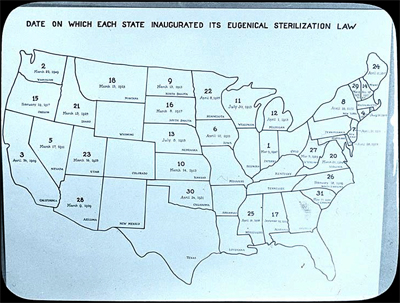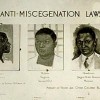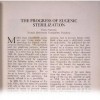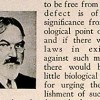Sterilization Laws
Based on a task force recommendation, the North Carolina legislature is considering paying $50,000 to living individuals sterilized by the state against their will or without their knowledge. North Carolina reportedly sterilized 7,600 individuals between 1929 and 1974. However, other American states also passed laws legalizing sterilization; the first was passed in Indiana in 1907 with the intent of giving prison inmates vasectomies as a way to prevent the transmission of “degenerate traits.”
In 1914, eugenicist Harry Laughlin published a Model Eugenical Sterilization Law that proposed to authorize sterilization of the “socially inadequate” – people “maintained wholly or in part by public expense.” The law included sterilization of the “feebleminded, insane, criminalistic, epileptic, inebriate, diseased, blind, deaf, deformed, and dependent” – including “orphans, ne’er-do-wells, tramps, the homeless and paupers.” Laughlin’s publication was the basis for Virginia’s Eugenical Sterilization Act, passed in 1924, which was first tested in the well-known Buck v. Bell case.
It can be debated whether North Carolina’s offer of reparation is enough or appropriate compensation. At one time or another, 33 states had statutes under which more than 60,000 Americans were involuntary sterilized. At $50,000 each, that’s a staggering $3,000,000,000.
Visit the Eugenics Archive for images and information on sterilization laws and eugenicists’ justification for them.
| Print article | This entry was posted by Susan Lauter on January 18, 2012 at 2:51 pm, and is filed under Eugenics Archive. Follow any responses to this post through RSS 2.0. You can leave a response or trackback from your own site. |











